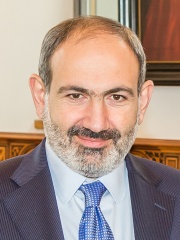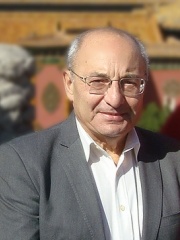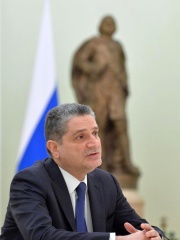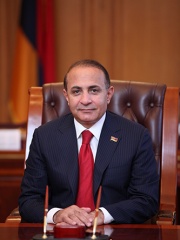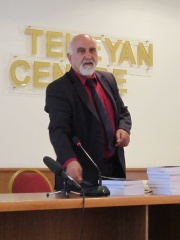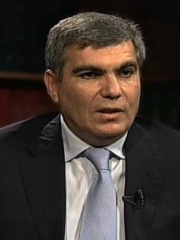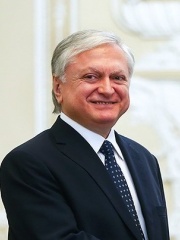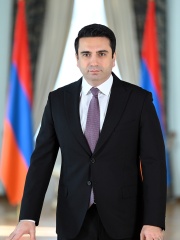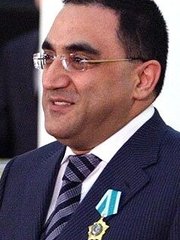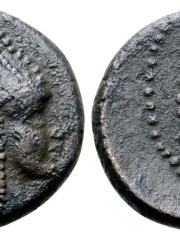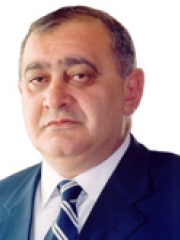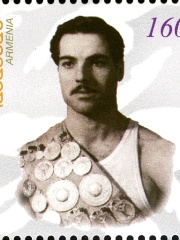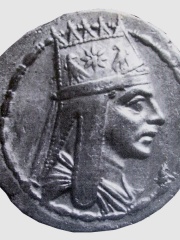
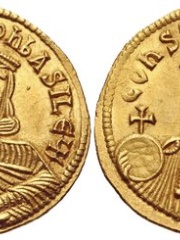
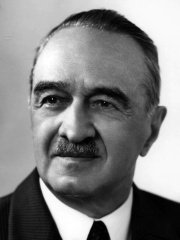
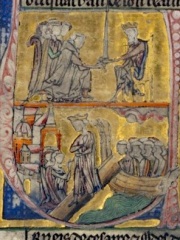
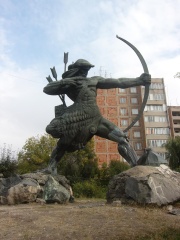
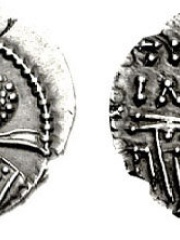
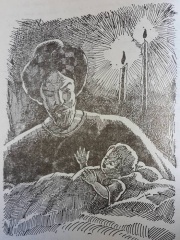
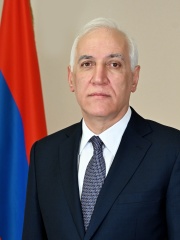
The Most Famous
POLITICIANS from Armenia
This page contains a list of the greatest Armenian Politicians. The pantheon dataset contains 19,576 Politicians, 31 of which were born in Armenia. This makes Armenia the birth place of the 89th most number of Politicians behind Guatemala, and Malaysia.
Top 10
The following people are considered by Pantheon to be the top 10 most legendary Armenian Politicians of all time. This list of famous Armenian Politicians is sorted by HPI (Historical Popularity Index), a metric that aggregates information on a biography's online popularity. Visit the rankings page to view the entire list of Armenian Politicians.

1. Tigranes the Great (140 BC - 55 BC)
With an HPI of 77.29, Tigranes the Great is the most famous Armenian Politician. His biography has been translated into 73 different languages on wikipedia.
Tigranes II, more commonly known as Tigranes the Great (Tigran Mets in Armenian; 140–55 BC), was a king of Armenia. A member of the Artaxiad dynasty, he ruled from 95 BC to 55 BC. Under his reign, the Armenian kingdom expanded beyond its traditional boundaries and reached its peak, allowing Tigranes to claim the title Great King or King of Kings. His empire for a short time was the most powerful state to the east of the Roman Republic. Either the son or nephew of Artavasdes I, Tigranes was given as a hostage to Mithridates II of Parthia after Armenia came under Parthian suzerainty. After ascending to the Armenian throne, he rapidly expanded his kingdom by invading or annexing Roman and Parthian client-kingdoms. Tigran decided to ally with Mithridates VI of Pontus by marrying his daughter Cleopatra. At its height, Tigranes' empire stretched from the Pontic Alps to Mesopotamia and from the Caspian Sea to the Mediterranean. With captured vassals, his lands even reached the Red Sea and the Persian Gulf. Many of the inhabitants of conquered cities were forcibly relocated to his new capital, Tigranocerta. An admirer of the Greek culture, Tigranes invited many Greek rhetoricians and philosophers to his court, and his capital was noted for its Hellenistic architecture. Armenia came into direct conflict with Rome after Mithridates VI was forced to seek refuge in Tigranes' court. In 69 BC, Tigranes was decisively defeated at the Battle of Tigranocerta by a Roman army under the command of Lucullus, and a year later he met another major defeat at Artaxata, the old Armenian capital. The recall of Lucullus gave Tigranes a brief respite, but in 66 BC Armenia faced another Roman invasion led by Pompey, aided by Tigranes' own son, Tigranes the Younger. Tigranes chose to surrender and was allowed to retain the heartland of his kingdom as a Roman buffer state, while all of his conquests were annexed. He continued to rule Armenia as a client-king of Rome until his death around 55 BC at the age of 85.

2. Leo V the Armenian (775 - 820)
With an HPI of 74.36, Leo V the Armenian is the 2nd most famous Armenian Politician. His biography has been translated into 53 different languages.
Leo V the Armenian (Greek: Λέων ὁ Ἀρμένιος, Léōn ho Arménios; c. 775 – 25 December 820) was the Byzantine emperor from 813 to 820. He is chiefly remembered for ending the decade-long war with the Bulgars, as well as initiating the second period of Byzantine iconoclasm. A senior general of Armenian origin, Leo distinguished himself under Nikephoros I and Michael I Rhangabe, eventually becoming the stratēgos of the Anatolic Theme. Taking advantage of Michael's defeat at the Battle of Versinikia, he forced the emperor to abdicate in his favour. He was able to withhold the blockade of Constantinople by Krum of Bulgaria and, after Krum's death, concluded a 30-year peace with his successor Omurtag. In 815, Leo deposed Patriarch Nikephoros and reinstituted iconoclasm. He was assassinated by supporters of Michael the Amorian, one of his most trusted generals, who succeeded him on the throne in 820.

3. Anastas Mikoyan (1895 - 1978)
With an HPI of 73.55, Anastas Mikoyan is the 3rd most famous Armenian Politician. His biography has been translated into 59 different languages.
Anastas Ivanovich Mikoyan (; Russian: Анастас Иванович Микоян, IPA: [ɐnɐsˈtas ɨˈvanəvʲɪtɕ mʲɪkɐˈjan]; Armenian: Անաստաս Հովհաննեսի Միկոյան, romanized: Anastas Hovhannesi Mikoyan; 25 November [O.S. 13 November] 1895 – 21 October 1978) was a Soviet statesman, diplomat, and Bolshevik revolutionary who served as the Chairman of the Presidium of the Supreme Soviet, the head of state of the Soviet Union. As a member of the Communist Party's Central Committee from 1923 to 1976, he was the only Soviet politician who remained in power from Lenin, through the eras of Stalin and Khrushchev, to his retirement under Brezhnev. His longevity inspired the popular Russian saying "from Ilyich [Lenin] to Ilyich [Brezhnev] without heart attack and paralysis." An ethnic Armenian, Mikoyan joined the Bolsheviks in 1915, and following the October Revolution of 1917 participated in the Baku Commune. In the 1920s, he was the party's boss in the North Caucasus. Mikoyan was elected to the Politburo in 1935, served as foreign trade minister from 1926 to 1930 and again from 1938, and during World War II became a member of the State Defense Committee. After the war, Mikoyan began to lose favour, losing his position as minister in 1949 and being criticized by Stalin at the 19th Party Congress in 1952. Following Stalin's death in 1953, Mikoyan sided with Khrushchev, supported him against a failed coup in 1957, and played a leading role in crafting his de-Stalinization policy. Under Khrushchev, Mikoyan played an important role in Soviet foreign policy, making several key trips to the United States and communist Cuba. He acquired an important stature on the international diplomatic scene, especially with his skill in exercising soft power to further Soviet interests. In 1964, Khrushchev was forced to step down in a coup that brought Brezhnev to power. Mikoyan briefly served as Chairman of the Presidium of the Supreme Soviet, the nominal head of state, from 1964 until his forced retirement in 1965.

4. Shirkuh (1100 - 1169)
With an HPI of 70.09, Shirkuh is the 4th most famous Armenian Politician. His biography has been translated into 27 different languages.
Asad ad-Dīn Shīrkūh bin Shādhī (Kurdish: ئەسەدەدین شێرکۆ، شێرگوێ, romanized: Esed El-Dîn Şêrko, Şêrgûh; Arabic: أسد الدين شيركوه بن شاذي), (died 23 March 1169) was a Kurdish mercenary commander in service of the Zengid dynasty, then the Fatimid Caliphate and uncle of Saladin. His military and diplomatic efforts in Egypt were a key factor in establishing the Ayyubid dynasty in that country.
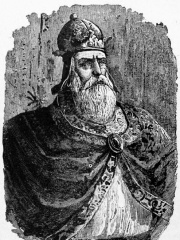
5. Tiridates III of Armenia (255 - 330)
With an HPI of 69.76, Tiridates III of Armenia is the 5th most famous Armenian Politician. His biography has been translated into 34 different languages.
Tiridates III (c. 250s – c. 330), also known as Tiridates the Great or Tiridates IV, was the Armenian Arsacid king from c. 298 to c. 330. In the early 4th century (301, according to tradition) Tiridates adopted Christianity as the state religion of Armenia, thus making the Kingdom of Armenia the first state to officially embrace Christianity.

6. Hayk (410 - 490)
With an HPI of 69.55, Hayk is the 6th most famous Armenian Politician. His biography has been translated into 40 different languages.
Hayk (Armenian: Հայկ, Armenian pronunciation: [hajk]), also known as Hayk Nahapet (Հայկ Նահապետ, Armenian pronunciation: [hajk nahaˈpɛt], lit. 'Hayk the Patriarch'), is the legendary patriarch and founder of the Armenian nation. He is a central figure in Armenian mythology and national identity, and is traditionally regarded as the eponymous ancestor from whom the Armenian people, the "Hay", derive their name. His tale is recounted in the History of Armenia attributed to the 5th-century historian Movses Khorenatsi, as well as in the Primary History attributed to Sebeos. Additional fragments of his legend survive in other medieval sources and continue to be echoed in Armenian oral tradition and epic poetry. According to legend, Hayk was a mighty archer and chieftain who defied the tyranny of the Babylonian ruler Bel. After leading his people out of captivity, he established their freedom by slaying Bel in the legendary Battle of Hayots Dzor around 2492 BC, near Lake Van in the Armenian Highlands. This foundational battle, in which Hayk is said to have struck Bel with a powerful arrow, symbolized both the spiritual triumph of justice over despotism and the birth of the Armenian nation.

7. Vologases V (130 - 208)
With an HPI of 68.96, Vologases V is the 7th most famous Armenian Politician. His biography has been translated into 38 different languages.
Vologases V (Parthian: 𐭅𐭋𐭂𐭔 Walagash) was King of Kings of the Parthian Empire from 191 to 208. As king of Armenia (r. 180–191), he is known as Vologases II. Not much is known about his period of kingship of Armenia, except that he put his son Rev I (r. 189–216) on the Iberian throne in 189. Vologases succeeded his father Vologases IV as king of the Parthian Empire in 191; it is uncertain if the transition of power was peaceful or if Vologases took the throne in a civil war. When Vologases acceded the Parthian throne, he passed the Armenian throne to his son Khosrov I (r. 191–217). Vologases' reign was marked by war with the Roman Empire, lasting from 195 to 202, resulting in the brief capture of the Parthian capital of Ctesiphon, and reaffirmation of Roman rule in Armenia and northern Mesopotamia. At the same time, internal conflict took place in the Parthian realm, with the local Persian prince Pabag seizing Istakhr, the capital of the southern Iranian region of Persis.

8. Najm ad-Din Ayyub (1100 - 1173)
With an HPI of 68.66, Najm ad-Din Ayyub is the 8th most famous Armenian Politician. His biography has been translated into 22 different languages.
al-Malik al-Afdal Najm al-Dīn Ayyūb ibn Shādhi ibn Marwān (Arabic: الملك ألأفضل نجم الدين أيوب بن شاذي بن مروان, Kurdish: نەجمەدین ئەییووبی شادی مەڕوان, romanized: Necmeddin Eyûbî Şadî Meřiwan; died August 9, 1173), or simply Najmadin, was a Kurdish mercenary and politician from Dvin, and the father of Saladin. He is the eponymous ancestor of the Ayyubid dynasty.

9. Vahagn Khachaturyan (b. 1959)
With an HPI of 68.10, Vahagn Khachaturyan is the 9th most famous Armenian Politician. His biography has been translated into 47 different languages.
Vahagn Garniki Khachaturyan (Armenian: Վահագն Գառնիկի Խաչատուրյան, pronounced [vɑˈhɑɡən χɑt͡ʃʰɑtuɾˈjɑn]; born 22 April 1959) is an Armenian economist and politician who has served as the fifth and current president of Armenia since 2022. He previously served as mayor of Yerevan from 1992 to 1996 and minister of High-Tech Industry from 2021 to 2022 under Prime Minister Nikol Pashinyan. He was a member of the Armenian National Congress (ANC) until his resignation in 2022, although he had not participated in party activities since 2017. He led the ANC list in the 2013 Yerevan City Council election.
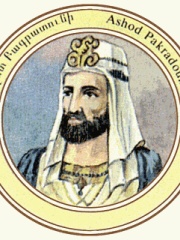
10. Ashot I of Armenia (820 - 890)
With an HPI of 67.01, Ashot I of Armenia is the 10th most famous Armenian Politician. His biography has been translated into 28 different languages.
Ashot I (Armenian: Աշոտ Ա; c. 820 – 890) was a king of Armenia who oversaw the beginning of Armenia's second golden age (862 – 977). He was the son of Smbat VIII the Confessor and was a member of the Bagratuni dynasty.
People
Pantheon has 31 people classified as Armenian politicians born between 350 BC and 1999. Of these 31, 14 (45.16%) of them are still alive today. The most famous living Armenian politicians include Vahagn Khachaturyan, Nikol Pashinyan, and Vazgen Manukyan. The most famous deceased Armenian politicians include Tigranes the Great, Leo V the Armenian, and Anastas Mikoyan. As of April 2024, 4 new Armenian politicians have been added to Pantheon including Armen Darbinyan, Arpine Hovhannisyan, and Hovhannes Danielyan.
Living Armenian Politicians
Go to all RankingsVahagn Khachaturyan
1959 - Present
HPI: 68.10
Nikol Pashinyan
1975 - Present
HPI: 62.94
Vazgen Manukyan
1946 - Present
HPI: 60.20
Tigran Sargsyan
1962 - Present
HPI: 59.98
Hovik Abrahamyan
1959 - Present
HPI: 59.05
Shavarsh Karapetyan
1953 - Present
HPI: 58.92
Paruyr Hayrikyan
1949 - Present
HPI: 54.95
Aram Sargsyan
1961 - Present
HPI: 52.90
Eduard Nalbandyan
1956 - Present
HPI: 51.65
Alen Simonyan
1980 - Present
HPI: 50.42
Armen Darbinyan
1965 - Present
HPI: 47.23
Arpine Hovhannisyan
1983 - Present
HPI: 39.19
Deceased Armenian Politicians
Go to all RankingsTigranes the Great
140 BC - 55 BC
HPI: 77.29
Leo V the Armenian
775 - 820
HPI: 74.36
Anastas Mikoyan
1895 - 1978
HPI: 73.55
Shirkuh
1100 - 1169
HPI: 70.09
Tiridates III of Armenia
255 - 330
HPI: 69.76
Hayk
410 - 490
HPI: 69.55
Vologases V
130 - 208
HPI: 68.96
Najm ad-Din Ayyub
1100 - 1173
HPI: 68.66
Ashot I of Armenia
820 - 890
HPI: 67.01
Tigranes III
100 BC - 100 BC
HPI: 63.98
Andranik Margaryan
1949 - 2007
HPI: 62.75
Albert Azaryan
1929 - 2023
HPI: 62.48
Newly Added Armenian Politicians (2025)
Go to all RankingsArmen Darbinyan
1965 - Present
HPI: 47.23
Arpine Hovhannisyan
1983 - Present
HPI: 39.19
Hovhannes Danielyan
1987 - Present
HPI: 35.71
Arsen Harutyunyan
1999 - Present
HPI: 35.63
Overlapping Lives
Which Politicians were alive at the same time? This visualization shows the lifespans of the 6 most globally memorable Politicians since 1700.

